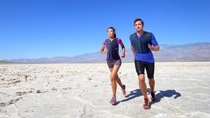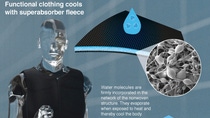Media
Ice, ice, baby—mobile air conditioners keep you cool on the go
BASF’s innovative material supports the cooling system of the human body.

This summer might be sweltering—reaching 90-degree levels—but you don’t have to be. If you’re a runner, traveler or worker exposed to high temperatures, you can now strap on a mobile air conditioner—in the form of a cooling vest, for instance—and venture into the outdoor heat. The special superabsorbent fleece from BASF provides evaporative cooling that is individually dosable and lasts for hours.
The functioning cooling textiles of customer brands E.COOLINE and IdeniXx incorporate a specially developed superabsorbent nonwoven fabric from BASF, which offers a wearable mobile air conditioning system that supports the cooling system of the human body.
They are easy to use and can be worn as any other attire once being activated by “charging” with water. The liquid enters the active layer called the Luquafleece from BASF, after being quickly absorbed and distributed through a bacteriostatic textile fabric.
“The fibers of this nonwoven fabric are coated with superabsorbent polymers (SAP) through a special technology,” said Norbert Heidinger, BASF New Business GmbH, who markets the material, in a statement. “They absorb the water in a few seconds and retain it.”
Like a fishing net, the polymer network of the superabsorber traps increasing numbers of water particles until its elastic restoring forces compensate the osmotic forces of the prevailing concentration gradient. Thus, Luquafleece can absorb 10 times its weight in water and retain it so firmly that the functional textiles are dry on the surface.
With higher outdoor temperatures or increased skin temperature during sports or work activity, the molecules firmly bind inside the functional cooling clothing, absorbing the thermal energy, evaporating from the large surface of the 3-D nonwoven structure, and cooling the wearer. As a result, the body sweats less and therefore saves energy that would usually be needed for thermoregulation. External cooling provides an increase in performance of up to 10 percent in hot conditions. Additionally, vital body parameters, such as heart rate, are improved, protecting the wearer’s health.


The functional garb also only cools the body to the extent required by the prevailing situation. The intensity of evaporative cooling adapts to the surrounding temperature and exertion. Therefore, no negative cooling effects can occur.
Since the World Football Championship in 2014 in Brazil, functional cooling textiles have been used at many international sporting events worldwide. For instance, the national football teams from Switzerland, Ireland and the U.S. nowadays use these cooling vests and headgear to improve their recovery during the half-time interval or before energy-intensive extra time.
“After a while, you don’t even notice the cooling anymore, because the body is air-conditioned,” said Gabriele Renner, CEO of manufacturing company ‘pervormance international GmbH’ in Ulm, Germany, who produces E.COOLINE, in a statement.
Presently, the company’s main application of cooling material is in the field of occupational health and safety. But medicine is another field of application in the future, according to Renner.
“Here we have already shown that we can significantly improve quality of life of people affected by multiple sclerosis with our cooling vests,” she added. “There are also other valuable uses such as treating menopausal complaints, such as hot flashes or reducing fever with our calf coolers.”
BASF’s Luquafleece is also used for wound dressing, marketed under Enluxtra in the U.S, which also creates ideal air conditioners for wound healing.
Published by Staff Writer.
For media inquiries or to repurpose this article, please contact Lisa Brown.